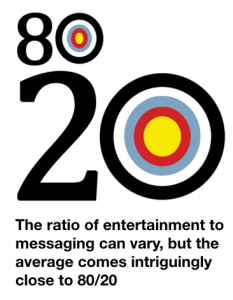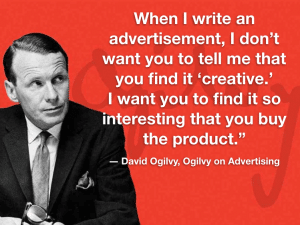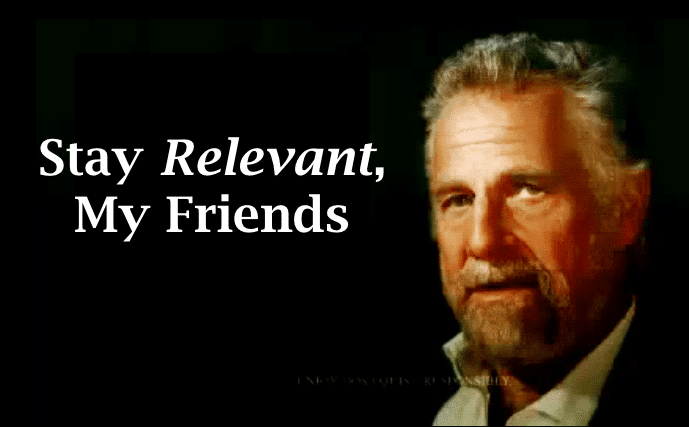In previous articles, I’ve made the point that the persuasive and mathematical strength for branding ads is that they speak to customers before they’re ready to buy.
I’ve also said that this is also branding ads’ fundamental challenge as well.
Because people who don’t need what you’re selling have no reason to pay attention to your ad — it’s irrelevant to them.
Which is why creativity and entertainment are so crucial to branding ads.
If you give people entertainment, they will give you their time and attention.
As I put it previously, “A spoonful of entertainment makes the messaging go down”
And while that’s a catchy Mary Poppins-ism, I fear it might have misled on you on two absolutely CRUCIAL points:
- The Ratio of Entertainment to Messaging, and
- The Relationship of the Entertainment to the Messaging
See, it’s perfectly possible to have entertaining ads that fail miserably when it comes to winning the sale, increasing revenue, gaining marketshare, etc — you know, all the reasons any business owner ever advertises, in the first place.
We’ll look at some of these famous failures later in this article, but for now, let’s look at some success in terms of…
The Ratio of Entertainment to Messaging
 In stark contrast to the notion of a “spoonful” of entertainment, most ads from highly successful branding campaigns are two-thirds to ninety percent entertainment.
In stark contrast to the notion of a “spoonful” of entertainment, most ads from highly successful branding campaigns are two-thirds to ninety percent entertainment.
For emphasis, these successful, revenue enhancing, and market-share grabbing ads are 66% to 90% entertainment.
A 30-second TV ad might have only 5 to 10 seconds of (explicit) messaging.
Take a gander at this ad from Dos Equis’ Most Interesting Man campaign:
The first 22 seconds or so of that ad are pure entertainment.
Not one mention of either beer or Dos Equis, until the last 8 seconds or so, when the Most Interesting Man utters his famous — and famously memed — tag lines of:
“I don’t always drink beer, but when I do, I prefer Dos Equis”
and
“Stay thirsty, my friends.”
Or if you prefer a shorter or longer format, there’s one of my all-time favorite ads for Clorox, measuring in at 15 seconds:
Notice again that it’s only the last 3 seconds or so that deliver the messaging and feature the brand.
And there’s this 60-second spot for Under Armour:
Which, again, only delivers the messaging in the last few seconds.
And in case you were wondering just how well an ad actually works when it spend most of it’s time entertaining, here are some stats for those campaigns:
- Dos Equis sales grew 30% over X years of the Most Interesting Man campaign, during an industry-wide sales decline
- Clorox reported a 9% revenue growth during the run of their For Life’s Bleachable Moments campaign
- And Under Armour has added more than $1.2 billion to total revenue since 2015 at an average annual rate of 9.4% with steady growth across all operating segments.
And, if you’re interested in seeing what it looks like when brand’s screw-up the “entertainment” portion of the ad — where the ad creatives and client were WAY too eager to move onto the messaging — you can check out this Mazda ad:
Note that this ad flips the ratio: 10 seconds of “entertainment” and 20 seconds of messaging.
So while I understand that it’s natural to think of spending 66% to 90% of your ad on entertainment as wasted, as I’ve mentioned before, it’s the wasted part that works.
And for two reasons:
- First, the entertainment does a lot more than merely entertain, and
- Second, 33% of a watched ad beats 100% of a tuned-out ad.
To hammer that second point home:
It’s never a question of going from having 100% of your air time for messaging down to 10% or 30%
It’s a question of going from 0% of your ad being heard, to actually having even 10% of your messaging sink in and acted upon when it counts — i.e, when it’s time to buy.
But let’s go back to the idea that the entertainment does more than entertain…
The Relationship of the Entertainment to the Message
As any legitimate ad wizard will tell you: branding is actually bonding.
You want the person to bond with your brand/company. To like you. To believe that you hold and express similar values to them. To feel that you’re their kind of company.
 A good branding ad will bond you to the audience by associating your brand with the values, emotions, and desires that already exist in the heart of the customer.
A good branding ad will bond you to the audience by associating your brand with the values, emotions, and desires that already exist in the heart of the customer.
And before you can associate yourself with that stuff, your ad has to evoke it in the audience.
It doesn’t do any good to associate Dos Equis with the Most Interesting Man unless and until the viewer believes the guy to really be this absurdly larger than life figure.
And you have to believe this about him while liking him, rather than resentfully and competitively comparing yourself to him. So the humor becomes a must.
Only AFTER all that is evoked within the customer, can the ad then transfer that onto the brand through association and direct endorsement.
But notice also that the humor is organic both to the strategy and the brand.
Dos Equis is a premium, sort of “exotic” beer from a Spanish-speaking country. It naturally evokes a sense of Hemingway about it.
So a Hemingway-esque figure makes a natural spokesperson.
And the target audience was younger men who were as likely to drink mixed cocktails as beer (hence the: “I don’t always drink beer” line) so having a figure they could admire yet feel aspirational about rather than competitive is a natural fit.
Again, the entertainment is organic to the persuasion.
Missed Connections and Famous Failures
 Whenever that’s not the case — whenever your humor or entertainment is merely tacked onto the messaging — your ad is like that “Fosbury Flop” Mazda ad.
Whenever that’s not the case — whenever your humor or entertainment is merely tacked onto the messaging — your ad is like that “Fosbury Flop” Mazda ad.
The technical name for this strategy is “borrowed interest.” You connect something interesting to your product through some kind of loose analogy.
Borrowed interest is a strategy that rarely works at all, and never works well.
Taco Bell’s Yo Quiero Taco Bell was a well-loved, entertaining ad campaign, but sales actually declined over the course of the campaign.
Sales of Chihuahuas increased dramatically, as that was what the creativity and entertainment was based on. But because it was totally unrelated to the food, no one made the connection.
And since we’re heading into Super Bowl Sunday, I’ll give you a Super Bowl spot example of a wildly “creative” ad that failed to move the sales needle due to a total lack of connection between the entertainment and the messaging:
This is why the entertainment has to be inherently related to the persuasion and the message.
Creativity in a branding ad is meant to entertain, for sure. But it is also meant to craft the entertainment from the inherent truth of the brand and its product.
If your ad “creative” can do that, hold onto your advertising team with both hands so you can grow rich together.
If they can’t, get yourself a new advertising team.

- Getting a Foot in the Door — Of Perception - November 27, 2025
- What Digital Superstars Know About Offline Advertising - November 17, 2025
- Unmistakable: A Tale of Two Boots and Branding Done Right - November 8, 2025
